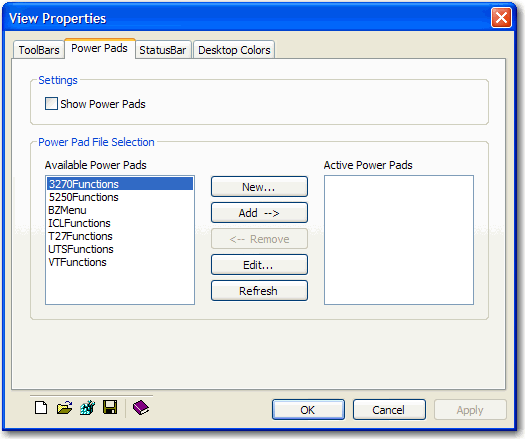 Using the Display Interface
Using the Display Interface
 Using the Display Interface
Using the Display Interface
Power Pads are configured using the Power Pads tab of the View Properties dialog.
To make an existing Power Pad launch with your BlueZone session:
From the BlueZone MenuBar, choose View:Properties and click the Power Pads tab. You will be presented with the Power Pads Settings dialog as shown here:

In the Power Pad File Selection section, a list of sample Power Pads will be displayed in the Available Power Pads list on the left.
These sample Power Pads mimic the old default Power Keys. The BZMenu Power Pad contains all the default BlueZone Menu Power Keys. The other sample Power Pads (3270Functions, 5250Functions, etc.) contain all the default Function Power Keys for each BlueZone emulation client. The names of the sample Power Pads match the emulation client.
In the Settings section at the top, make sure that the Show Power Pads checkbox is enabled. This checkbox must be enabled in order for the Power Pads shown in the Active Power Pads list to be displayed on the desktop. If this checkbox is not enabled, the Power Pads will remain in the Active Power Pads list but will not be displayed on the desktop.
Highlight the desired Power Pads in the Available Power Pads list and click the Add button. The selected Power Pads will be added to the Active Power Pads list on the right.
Click the OK button and all active Power Pads will launch.
Save and close the BlueZone emulation session.
The next time you launch this BlueZone session, the Power Pads that you added to the Active Power Pads list will launch at the same time.
 NOTE Closing
a Power Pad, by clicking the Power Pad's X, during a BlueZone session
will not remove
it from the Active Power Pads list. This
only temporarily closes the Power Pad.
NOTE Closing
a Power Pad, by clicking the Power Pad's X, during a BlueZone session
will not remove
it from the Active Power Pads list. This
only temporarily closes the Power Pad.
If you want to temporarily turn off all Power Pads, without
removing them from the Active Power Pads list, un-check the Show Power
Pads checkbox located in the Settings section. Also,
if desired, you can add a Toggle Power
Pads icon ![]() to the BlueZone ToolBar
to toggle the Power Pads in your Active Power Pads list, on and off.
to the BlueZone ToolBar
to toggle the Power Pads in your Active Power Pads list, on and off.
 SEE View
Properties under ToolBar Settings
and choose the desired ToolBar Settings
link for help with customizing the BlueZone ToolBar.
SEE View
Properties under ToolBar Settings
and choose the desired ToolBar Settings
link for help with customizing the BlueZone ToolBar.
Clicking the New or Edit buttons will cause the Power Pad Editor to launch.
 SEE The
Power Pad Editor
for more information.
SEE The
Power Pad Editor
for more information.
The Refresh button is used when you have just created a new Power Pad that does not yet appear in the Available Power Pads list.
To remove a Power Pad from the Active Power Pads list, use the Remove button.
Power Pads can take up a lot of room on your desktop. It is possible to create multiple Power Pads and have them all occupy the same exact spot on your desktop. In order to display each Power Pad in turn, use the Next Power Pad feature.
The Next Power Pad feature is accessed via the BlueZone MenuBar. Select View:Next Power Pad from the menu. Focus will be given to each Power Pad in turn.
Also, by default, there is a Next
Power Pad icon ![]() on the BlueZone ToolBar,
which when clicked, will select the next Power Pad in your Active Power
Pads list.
on the BlueZone ToolBar,
which when clicked, will select the next Power Pad in your Active Power
Pads list.
 SEE View
Properties under ToolBar Settings
and choose the desired ToolBar Settings
link for help with customizing the BlueZone ToolBar.
SEE View
Properties under ToolBar Settings
and choose the desired ToolBar Settings
link for help with customizing the BlueZone ToolBar.
Related Topics:
Power Pad Editor - Introduction